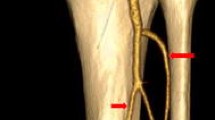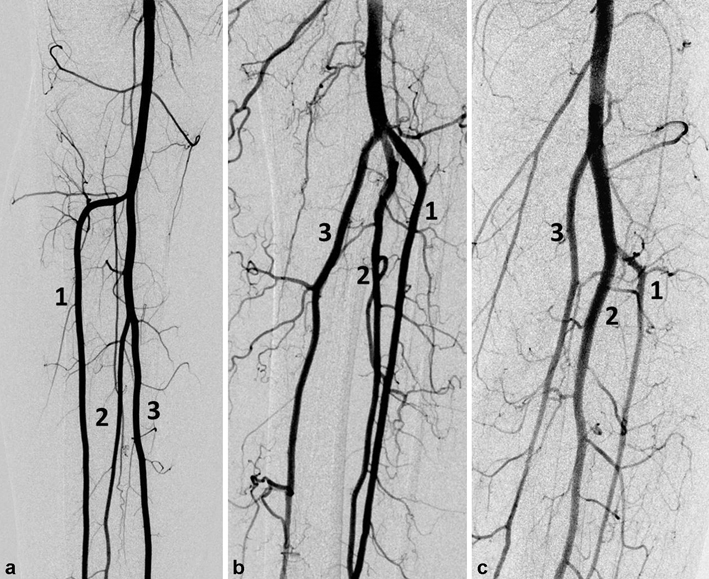Abstract
Objective
To date the anatomy of the popliteal artery variations using multidetector-row computed tomography angiography (MD CTA) was not assessed. The objective of this study is to establish 3D CT anatomy of the popliteal artery variations.
Materials and methods
A total of 126 lower limbs that underwent CTA using 64-detector MDCT were retrospectively reviewed. The anatomical variations of the distal popliteal artery branching were assessed.
Results
Ninety-seven lower limbs (83.6 %) had the usual branching pattern (type 1 A) with tibialis anterior artery (TA) arising first followed by the tibial-peroneal trunk, which then gives rise to the tibialis posterior artery (TP) and peroneal artery. Variations in popliteal branching pattern were seen in 19 (16.4 %) limbs. The commonest variation was first branch of the TP in 5 (4.4 %) of the limbs (type 1 C) or high origin with anterior course of popliteus muscle of the TA in 5 (4.4 %) limbs (type 2 A II).
Conclusion
Many variations exist in the running patterns of the branching pattern of the popliteal artery. Knowledge of the branching pattern of the popliteal artery will be beneficial to radiologist for the evaluation of CT angiograms and interventional vascular procedures, and to vascular surgeons for various surgical approaches. MD CTA provides noninvasive means of assessing distal popliteal artery variations.






Similar content being viewed by others
References
Atanasova M, Georgiev GP, Jelev L (2011) Intriguing variations of tibial arteries and their clinical implications. Int J Anat Var 4:45–47
Chin AS, Rubin GD (2006) CT angiography of peripheral arterial occlusive disease. Tech Vasc Interv Rad 9:143–149
Chow LC, Napoli A, Klein MB, Chang J, Rubin GD (2005) Vascular mapping of the leg with multi–detector row CT angiography prior to free-flap transplantation. Radiology 237:353–360
Collins R, Cranny G, Burch J, Aquiar-Ibanez R, Craig D, Wrihgt K et al (2007) A systematic review of duplex ultrasound, magnetic resonance angiography and computed tomography angiography for the diagnosis and assessment of symptomatic, lower limb peripheral arterial disease. Health Technol Assess 11:1–184
Day CP, Orme R (2006) Popliteal artery branching patterns an angiographic study. Clin Radiol 61:696–699
Durham JR, Horowitz JD, Wright JG, Smead WL (1994) Percutaneous transluminal angioplasty of tibial arteries for limb salvage in the high-risk diabetic patient. Ann Vasc Surg 8:48–53
Jiji PJ, D’Costa S, Nayak SR, Prabhu LV, Pai MM, Vadgaonkar R, Rai R, Sugavasi R (2008) Hypoplastic posterior tibial artery and the enlarged peroneal artery supplying the posterior crural region: a rare variation. J Vasc Bras 7:272–274
Kil SW, Jung GS (2009) Anatomical variations of the popliteal artery and its tibial branches: analysis in 1242 extremities. Cardiovasc Interv Radiol 32:233–240
Kim D, Orron DE, Skillman JJ (1989) Surgical significance of popliteal arterial variants. A unified angiographic classification. Ann Surg 210:776–781
Klecker RJ, Winalkski JS, Aliabadi P, Minas T (2008) The aberrant anterior tibial artery: magnetic resonance appearance, prevalence and surgical implications. Am J Sports Med 36:720–727
Lippert H, Pabst R (1985) Arterial variations in man: classification and frequency. J. F Bergman Verlag, Munich
Lohan DG, Tomasian A, Krishnam M, Jonnala P, Blackwell KE, Finn JP (2008) MR angiography of lower extremities at 3 T: presurgical planning of fibular free flap transfer for facial reconstruction. AJR Am J Roentgenol 190:770–776
Mauro MA, Jaques PF, Moore M (1988) The popliteal artery and its branches: embryological basis of normal and variant anatomy. AJR Am J Roentgenol 150:435–437
Mavili E, Dönmez H, Kahriman G, Ozaşlamacı A, Ozcan N, Tasdemir K (2011) Popliteal artery branching patterns detected by digital subtraction angiography. Diagn Interv Radiol 17:80–83
Ozgur Z, Ucerler H, Aktan Ikız ZA (2009) Branching patterns of the popliteal artery and its clinical importance. Surg Radiol Anat 31:357–362
Senior HD (1919) An interpretation of the recorded arterial anomalies of the human leg and foot. J Anat 53:130–717
Singla R, Kaushal S, Chabbra U (2012) Popliteal artery branching pattern: a cadaveric study. Eur J Anat 16:157–162
Shareghi S, Gopal A, Gul K, Manchinson JC, Wong CB, Winberg N et al (2010) Diagnostic accuracy of 64 multidetector computed tomographic angiography in peripheral vascular disease. Catheter Cardiovasc Interv 75:23–31
Tindall AJ, Shetty AA, James KD, Middleton A, Fernando KW (2006) Prevalence and surgical significance of a high-origin anterior tibial artery. J Orthop Surg 14:13–16
Zhong H, Gan J, Zhao Y, Xu Z, Liu C, Shao G, Wu X (2011) Role of CT angiography in the diagnosis and treatment of popliteal vascular entrapment syndrome. AJR Am J Roentgenol 197:1147–1154
Conflict of interest
I certify that there is no actual or potential conflict of interest in relation to this article. All other authors have no conflicts of interest.
Ethical standards
Institutional ethics committee approval was obtained prior to the study.
Author information
Authors and Affiliations
Corresponding author
Rights and permissions
About this article
Cite this article
Yanik, B., Bulbul, E. & Demirpolat, G. Variations of the popliteal artery branching with multidetector CT angiography. Surg Radiol Anat 37, 223–230 (2015). https://doi.org/10.1007/s00276-014-1346-y
Received:
Accepted:
Published:
Issue Date:
DOI: https://doi.org/10.1007/s00276-014-1346-y




